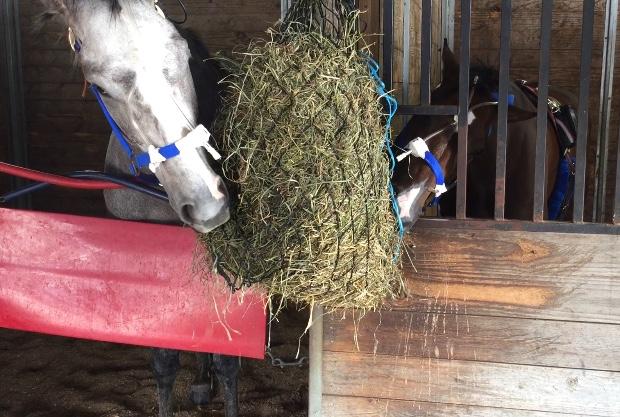
Horse Health News: Purdue University Conducts Equine Asthma Research
With current estimates stating that 20-50% of stalled horses develop asthma, Purdue University’s study on dust levels in forage could be a real game-changer. Noelle Maxwell speaks with the research team to learn more.
Thanks to funding received from the Grayson Jockey Club Research Foundation, a Purdue University study team led by Dr. Laurent Couëtil and Dr. Kathleen Ivester has been conducting research into equine asthma and dust exposure. The study, which started in May, is being conducted at Indiana Grand and will continue through the 2019 race meet.
According to Dr. Kathleen Ivester, actively racing Thoroughbreds are “ideal [for the study] because of the large numbers of horses available in one location and the high incidence of asthma in this population; it’s a common problem in these horses and very important for them and their caretakers.” As racehorses perform at maximum intensity and are limited by the efficiency of the respiratory system, a race can be won or lost through slight changes to the airway; since race results are carefully tracked, it’s also easier to track the study’s effect on the horses’ performance.
While the study uses actively racing Thoroughbreds, it has the potential to impact the wider horse world. Ivester mentioned that “research has shown that lower intensity performance, such as jumping, can be negatively impacted by mild asthma.”
According to Ivester, incidence rates for asthma vary depending on how horses are managed and what discipline they compete in. Current estimates indicate that 20% to 50% of stalled horses have asthma, regardless of discipline. Ivester added that in a previous study conducted at the racetrack by the same team of researchers, airway inflammation was detected in roughly 80% of examined racing Thoroughbreds.
The current study’s goal was to measure dust exposure levels when horses were fed three types of forage: hay, steamed hay, and haylage. Researchers measured respirable dust exposure and particle numbers in the air surrounding the horses’ “breathing zones” and studied the proportions of inflammatory cells found deep within the horses’ airways when the horses were fed different types of forage. The hypothesis is that low-dust forages, such as steamed hay and haylage, can reduce airway inflammation without using medications or interrupting the training schedule.
So far, the data suggests that haylage provides the lowest dust exposure, and dry hay, as anticipated, provides higher dust exposure; steamed hay meanwhile, provides lower dust exposure than dry hay, but higher exposure than haylage. However, Ivester emphasized that the study is still ongoing with no final conclusions; this is merely what the data thus far suggests.
As for the impact on average horse owners, Ivester stated that the “average horse owner should know that keeping horses at pasture, for the most part, is best for respiratory health. Confining horses to a stall results in higher dust exposure which can induce inflammation. In stalled horses, dust exposure is mostly impacted by forage; horses with severe asthma usually require a complete pelleted feed to avoid asthma triggers in even the best quality hay. Also, round bales have been shown to be associated with higher dust exposure and increased risk of asthma.”











Leave a Comment